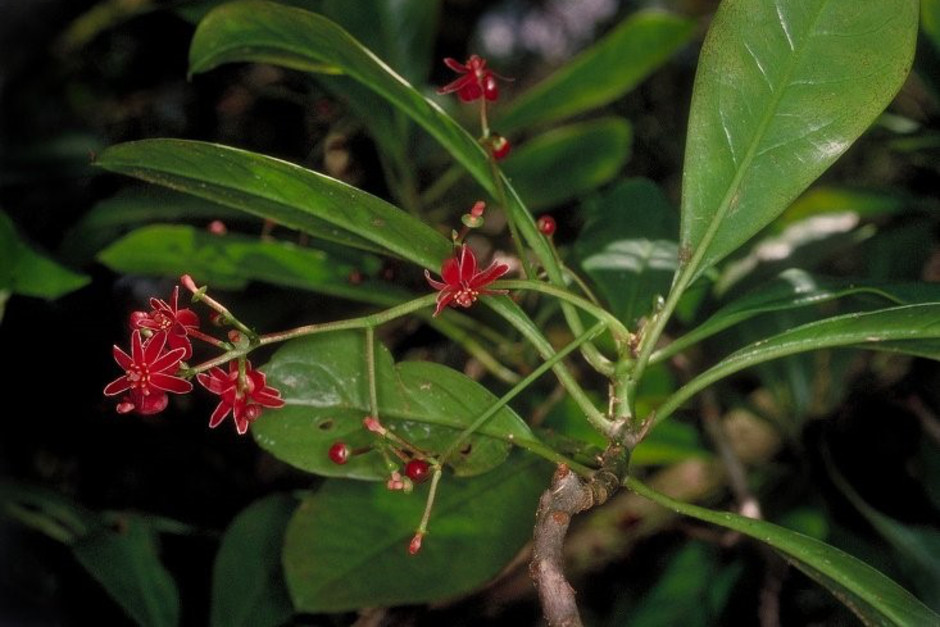Forskningsområden: Botanik, Paleontologi
Forskningsämnen: Madagaskar
Project overview
Project period: 2020-2025
Participating departments from the museum: BOT, PAL
Madagascar is renowned for its high levels of endemism and species diversity mostly originated via in-situ diversification. Various hypotheses have been proposed to account for the species diversity and diversification patterns on this continental island. The purpose of the project is to conduct an integrative study on the diversity and evolutionary history of the conifer and flowering plants in Madagascar, using the conifer genus Podocarpus (Podocarpaceae) and the three Malagasy flowering plant genera Payera and Schismatoclada (Rubiaceae) and Takhtajania (Winteraceae) as showcases.
Project description
A major mass extinction event took place at the end of Cretaceous – 66 MYA, wiping 75% of species. My project is divided into two subprojects.
Subproject 1
Focuses on the Malagasy flagship genus Takhtajania Baranova & J.-F. Leroy, one of the Gondwana plant relicts that survived the Cretaceous-Paleogene extinction event, and the largest conifer genus Podocarpus, with a particular focus on the Malagasy species. Presently delimited as a monospecific genus, Takhtajania (Winteraceae, Canellales) is argued to be the sole surviving angiosperm to have originated in Madagascar as a result of Gondwanan vicariance. The present species diversity of Takhtajania has been challenged following the successive discoveries of geographically, bioclimatically and morphologically distinct populations in eastern and northeastern Madagascar.
All Malagasy species of Podocarpus L’Hér. ex Pers. and the southern and eastern African species Podocarpus henkelii Stapf ex Dallim. & A.B. Jacks. are currently classified in the section Scytopodium of Podocarpus subgenus Podocarpus, raising questions regarding the monophyly of the Malagasy Podocarpus and their evolutionary history.
Subproject 2
Concentrates on two rubiaceous Malagasy endemic genera (Payera Baill. & Schismatoclada Baker) of Madagascar-centered tribe Danaideae (Rubiaceae), which occur in humid, sub-humid and mountain climate zones. Much of its species diversity is endemic to restricted, remote and/or mountainous areas of Madagascar and recent field work on the island indicates substantial unknown diversity of Payera and Schismatoclada. Our recent study revealed parallel northward diversification and geographically segregated lineages in these two genera despite their anemochorous condition.
Specifically, this project will:
- Conduct taxonomic revisions of Payera, Schismatoclada and Takhtajania. Risks of extinction assessments based on the IUCN Red List criteria, distribution maps and identification keys for all recognized species will be provided. Our revisions contribute towards the completion of the Flora of Rubiaceae for Madagascar (subproject 1-2).
- Investigate the phylogenetic patterns of the temporal and geographic diversification in Podocarpus, Payera and Schismatoclada in Madagascar (subproject 2);
- Assess whether the divergence times in these three genera are compatible with any of the proposed hypotheses to account for the species diversity and diversification patterns on the island (subproject 2).
- Match the geographic locations and times of their diversification rate shifts with past geoclimatic events (subproject 2).
Funding
- Royal Swedish Academy of Sciences (kva.se)
- Swedish Research Council (vr.se)
Selected publications
Krüger, Å., Razafimandimbison, S. G., Bremer B. 2012. Molecular phylogeny of the Madagascar-centred tribe Danaideae (Rubiaceae): another example of out-of- Madagascar dispersal. Taxon 61, 629-636. https://doi.org/10.1002/tax.613011 Länk till annan webbplats.
Länk till annan webbplats.
Razafimandimbison S. G., Kainulainen K., Wikström N., Bremer B. 2017. Historical biogeography and phylogeny of the pantropical Psychotrieae alliance (Rubiaceae), with particular emphasis on the Western Indian Ocean Region. American Journal of Botany 104, 1407-1423. doi: 10.3732/ajb.1700116
Strid, D., Kearey J., Razafimandimbison S. G. 2019. Schismatoclada spathula (Rubiaceae): a new species from the Marojejy National Park (northeastern Madagascar). Candollea 74, 202-203. DOI: http://dx.doi.org/10.15553/c2019v742a8
Razafimandimbison, S. G., Wikström, N., Khodabandeh A. Rydin C. 2022. Phylogeny of the Madagascar-centred tribe Danaideae (Rubiaceae) as a precursor to taxonomic revision: insights into its generic and species limits, affinities and distribution. Annals of Botany 130, 849-867. https://doi.org/10.1093/aob/mcac121 Länk till annan webbplats.
Länk till annan webbplats.
Project members
External participants
This project is run in collaboration with the Stockholm University and the Meise Botanic Garden (Belgium).
Project manager

Project member



